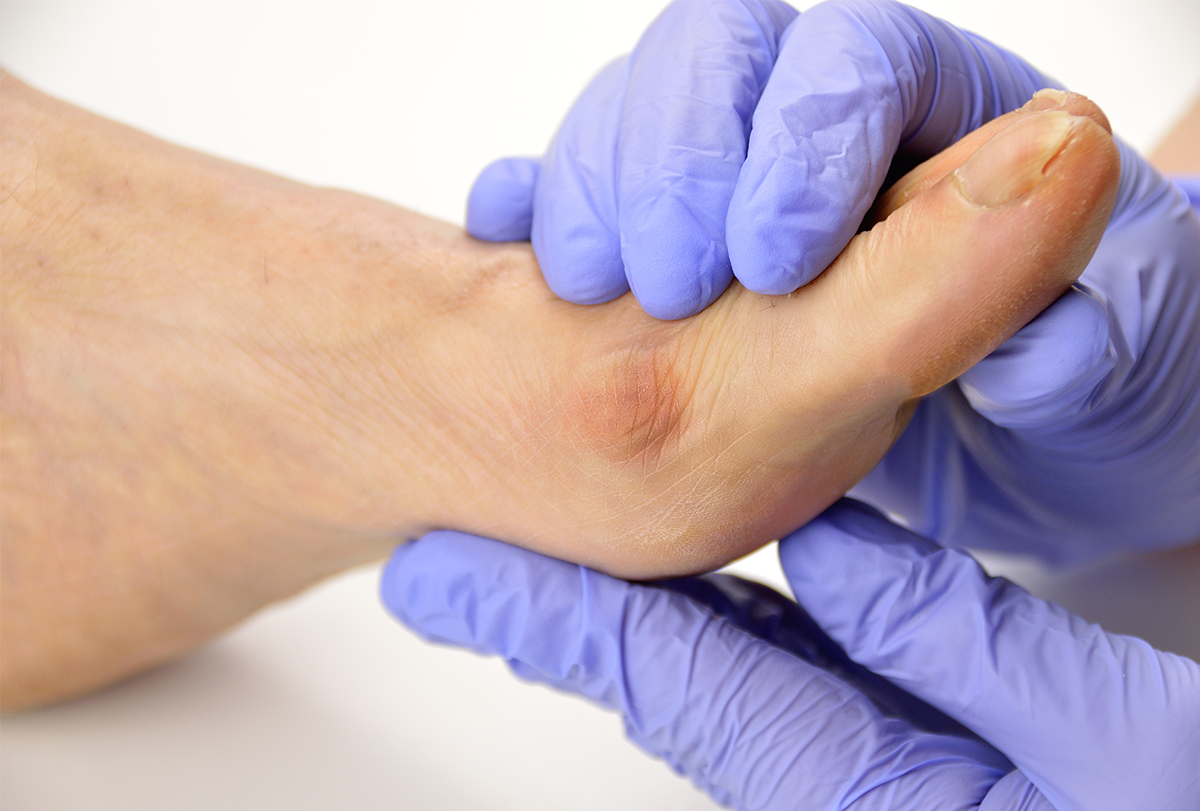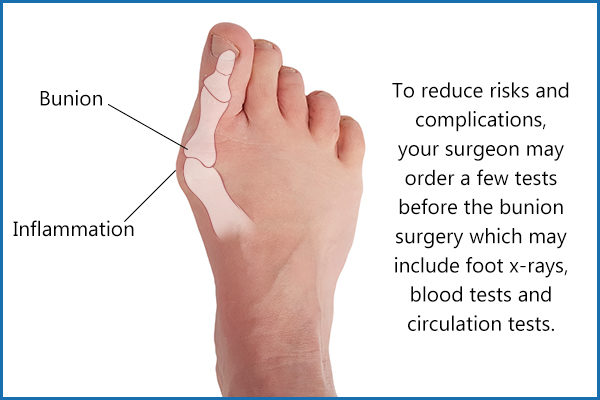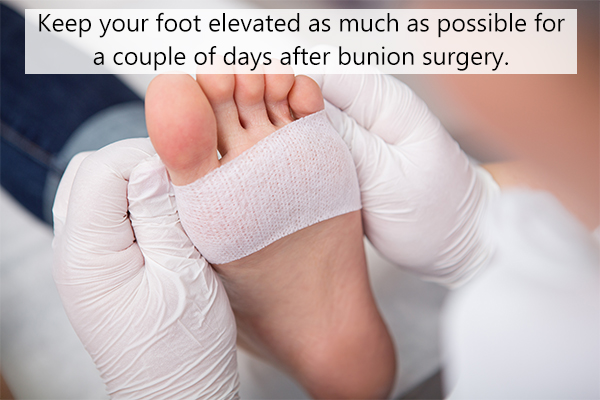In this article:
The medical term for a bunion is hallux valgus. It is characterized by a bump on the side of the big toe joint, indicating changes in the bone structure of the joint.

The big toe gradually sways toward the second toe instead of pointing straight. The bump then becomes increasingly noticeable. The big toe joint supports a large amount of your body weight when walking. Because of this, bunions can cause extreme pain if left untreated. (1)
Bunion Surgery Complications

A bunion surgery, like any surgery, cannot be expected to be without risk.
The following complications can occur after a bunion surgery if recovery is not as expected:
- Reaction to local anesthesia
- Hematoma or a collection of blood at the surgery site
- Reoccurrence of the bunion (5)
- Scarring or thickening of the skin incision
- Swelling for an extended period
- Delayed healing of the incision or bone cut
- Blood clot (deep vein thrombosis)
- Excessive bleeding
- Shortening of the big toe
- Thickened skin growth on the bottom of the foot (callus formation)
- Stiffness of the big toe joint
- Skin or bone infection
- Arthritis after surgery
- Nerve problems/numbness
- Loosening of hardware (screws, staples, wires) that have been put in your foot to hold the bone in place (5)
- Loss of blood flow to the bone or tissue
- Loss of big toe function
Bunion Surgery Recovery Time

- The bunion surgery recovery time could last from 6 weeks to 6 months, depending on the severity of your bunion. Complete healing may take up to 1 year. (4)
- The success of your bunion surgery will depend on how well you follow your surgeon’s instructions after surgery.
- The amount of pain experienced after bunion surgery differs with each individual. Most patients feel uncomfortable for a period of 3–5 days. Pain can be controlled with prescribed medications.
- After some procedures, you will not be able to walk on your foot for 6–8 weeks.
- Many activities can be resumed in about 6–8 weeks. After surgery, certain exercises will help strengthen your foot and increase the motion of your big toe joint. Your surgeon or physical therapist will educate you on these exercises.
- There may be a few weeks in which you are only allowed to put some weight and pressure on your foot in a special surgical shoe or boot with the assistance of crutches or a cane. The surgical shoe or boot will help keep the bones and soft tissues of the big toe joint still as they heal straight.
- Depending upon the type of bunion surgery you had, your bunion correction can be lost by walking on your foot too early or without proper support. Some bunion procedures allow you to walk on your foot right after the surgery with the use of a surgical shoe to protect the bunionectomy site.
- Stitch removal is usually performed in 14–21 days. If your surgeon used pins that stick out of the foot, the pins might be removed in about 4–6 weeks.
- There is always a possibility of bunions growing back after surgery. A variety of factors play a role:
- An inadequate choice of surgical procedure may be a cause of a bunion growing back after surgery.
- Incorrect tight-fitting shoes can cause a bunion deformity to return.
Here are some important things to keep in mind following a bunion surgery:
- Your surgeon will instruct you to rest, ice, and elevate your foot. Icing and elevation decrease swelling, which in turn can minimize pain. If you follow your surgeon’s instructions, you can help minimize pain and swelling after your bunion surgery.
- It is very important to follow your surgeon’s directions about bandage care after surgery. Keeping your big toe in the correct position after surgery is essential for the success of healing.
- Fashionable shoes should be avoided until your surgeon allows it. Also, note that your surgeon may advise you to never return to wearing high heels. Your surgeon will educate you on shoes when you are ready to transition to them.
How to Prepare for a Bunion Surgery?
Consider the following when preparing for a bunion surgery:
- Request time off from work: Discuss your recovery timeline with your surgeon in order to plan for your time off.
- Recruit a driver: You will need a driver during your recovery period.
- Follow instructions given to you by your surgeon: You will not be able to eat before the surgery for a certain amount of time. This is imperative because anesthesia administration could be affected if your body is digesting food. Your surgeon will instruct you about your diet.
- Wear comfortable, loose-fitting clothing to the hospital or surgery center: Almost all bunion surgeries are performed as an outpatient procedure. You will probably be asked to arrive at the hospital or surgical center 1–2 hours before the surgery.
How Is Bunion Surgery Performed?
Bunion surgery will involve the following:
- Most bunion surgeries are performed under local anesthesia with conscious sedation or twilight sleep. You are not fully put to sleep. After you are sedated, the bunion site is numbed locally with an injection.
- With a simple bunionectomy, just the bony bump on the side of the foot will be removed. In more severe bunion cases, a cut in one or more bones will be required.
- Bones will be held together with hardware, such as screws, plates, staples, or wires.
- X-rays will be performed throughout your surgery and following your surgery.
- Following surgery, you will be transferred to the recovery room where you will be monitored until you are cleared to go home, which could be in an hour or two. (3)
- You will be discharged from the hospital or surgery center with bandages on your foot, holding your toe in a straight position. Keeping your toe in this position is important during the healing process. It is important to follow your surgeon’s directions about your bandages. (4)
What are the Treatment Options for Bunions?
Once your surgeon has evaluated your bunion, a treatment plan can be developed to meet your individual needs, which typically begins with a nonsurgical approach. (2)
- Sometimes keeping an eye on the bunion is all that is needed.
- In other cases, however, some type of treatment is needed, such as the use of wide-width shoes, padding, shoe inserts, or injection therapy. The goal of early treatment includes easing the pain of the bunion and preventing the bunion from getting worse.
- A simple bunionectomy is indicated for minor deformities, wherein only the bony lump on the side of the big toe joint is removed.
- Severe bunions may need an extensive procedure to realign the structure of the big toe joint by cutting the bone and adjusting the framework of the joint, possibly with screws, plates, staples, and wires.
- Reversing a bunion is not possible with conservative management. Nonsurgical treatment, however, can help relieve pain and prevent the bunion from worsening.
What Are the Complications of Leaving Bunions Untreated?
If bunions are left untreated, more serious foot pain can occur. Also, the bunion may be more difficult to correct. An untreated bunion can lead to:
- Worsening discomfort
- Severe pain
- Difficulty walking
- Curling of the toes (4)
- Osteoarthritis
- Swelling and redness from rubbing with other toes and shoes that are too tight
- Pain that may spread from the toes to the whole foot and then to the knee, hip, and back
- Pain in the other foot due to compensation for the painful foot
- Hammertoes, (4) in which the middle toes may become deformed, curled, bent, or crossed over
When to See a Doctor
During your recovery period at home, contact your doctor if:
- Your dressing loosens.
- Your bandage comes off.
- Your bandage gets wet.
- You notice an odor from your surgical site.
- Your toe becomes pale or blue.
- You notice the pin if used during surgery, loosening and backing out of your toe.
- Your dressing is moistened with excessive amounts of blood or drainage.
- You experience side effects from medicine after surgery.
- You experience persistent fever.
- You have chills.
- You develop warmth or redness around the bandage.
- Your pain increases.
- You develop significant swelling in the calf.
- You experience calf pain.
- You develop shortness of breath.
Final Word
Bunion surgery can relieve foot pain. It can improve the alignment and motion of your big toe. The type of bunion surgery performed depends on the severity of your bunion.
Every bunion surgery is custom for each individual. The length of your recovery will depend on the type of bunion surgery and how well you follow your surgeon’s instructions after surgery to ascertain proper healing.
- Was this article helpful?
- YES, THANKS!NOT REALLY


